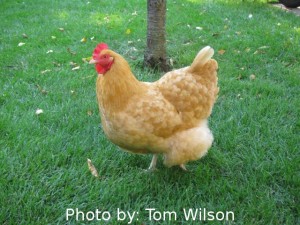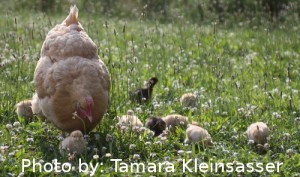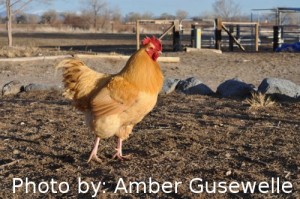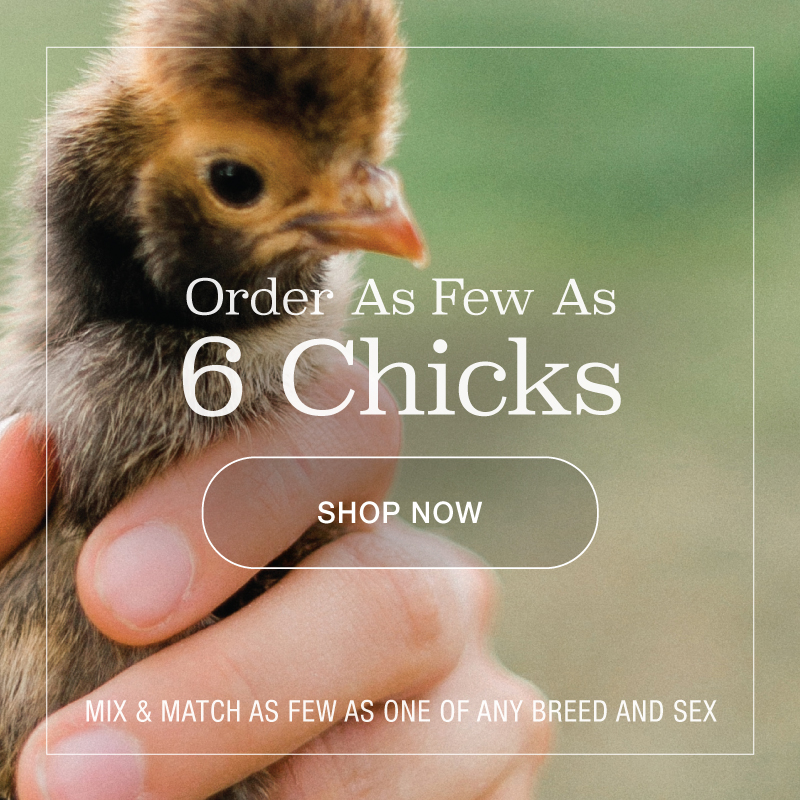 History
History
The original Orpington, a Black Orpington, was developed by William Cook, from the village of Orpington, County of Kent, England in the 1880s. In 1886 he introduced the Black Orpington at the Chrystal Palace Poultry Show, and his pullet won the grand prize.
To develop the Orpington, Cook crossed Black Minorcas with Black Plymouth Rocks, then crossed the resultant bird with clean-legged Langshans. The Buff Orpington was later developed through other crosses.
Qualities of the Buff Orpington
- Temperament – Orpingtons have a gentle, docile disposition. They are easily tamed and are even somewhat affectionate toward their handlers.

- Broodiness – Orpington hens go broody often and make excellent mothers.
- Climate –Orpingtons tolerate cold temperatures well, but the comb of the male is prone to frostbite and must be protected.
- Foraging – Orpingtons forage well on pasture. They also tolerate confinement well.
- Maturity Rate – The Orpington matures quickly.
Orpingtons are a dual-purpose breed. They are known for their calm temperament, good egg laying, and exceptional meat. Hens are good winter layers and lay light to dark brown eggs.
Physical Appearance of Buff Orpingtons
- Feathers –Their feathers are soft, fluffy, and profuse. They lay close to the body, and hide most of the legs.
- Coloration – Their skin is white. The beak is pinkish white, eyes are reddish bay, and shanks and toes are pinkish whites.
- Comb –Orpingtons have a single comb with five well-defined points. The combs are bright red and of medium size.
- Wattles – Bright red, medium size with well rounded lower edges.
- Earlobes –Bright red, medium size, oblong, and smooth.
Videos of Baby Buff Orpington Chicks
httpv://www.youtube.com/watch?v=n0IeQA4Elo4
Availability
- Buff Orpingtons — Buff Orpingtons are our most popular variety of Orpington.
- White Orpingtons —White Orpingtons have white plumage but are otherwise similar in appearance and characteristics to the Buff Orpington.
Feedback
Do you raise Orpingtons? Do you raise them in an urban, backyard setting or in a rural area? What has your experience with them been?





My Buff Orpingtons are running neck and neck with my Silver Lace Wyandottes and Red Star’s for attention. They seem to compete to be closest to me. Our Miniature Schnauzer has found the chickens very amusing. He follows them around sometimes herding them to a different place. There are two of the Orpingtons that will challenge him. They will run from some far off corner straight at him coming face to face. They will then stand as high as they can, ruffle their neck feathers and flap their wings while squacking at him. Then they may peck at him. He doesn’t know what to do except retreat. I have taught him not to bite so the birds see him cower then they are all on him herding him into a corner. Great fun to watch!
Roy
I have 15 Buff Orpingtons in a spacious coop. Inside the coop is a five-compartment laying box as well as a four-rung roost that angles out from one of the walls. Despite the adequacy of the roost, the birds insist on cramming themselves into four of the five nest boxes at night. They occasionally sit on the roost during the day. Since the birds should be laying in late August-mid September, should I do something to discourage their night time roosing in the laying boxes?
The main problem with night time roosting in the laying boxes is that they will also drop manure into the nest boxes overnight. One thing to try is raising your roosts so that they are higher than the nest boxes. This works because chickens tend to roost in the highest spot.
The roosts ARE higher than the nest boxes. The nest boxes, however do have a 5 inch “porch” of sorts that makes it easy for them to hang out there and in the nest boxes themselves. My idea for the “porch” was to allow them someplace to jump up to before heading in to the boxes, rather than having to jump up in to the boxes right off. Perhaps I could cut off half the “porch” and make it a little less appealing. They already are leaving plenty of droppings and I would like them to get used to another roosting spot soon, since they should begin laying in about 6 weeks or so. I often find them on the roost which I made for them, but only during the day.
Help – we have a Buff Orpington – (no rooster) but she is sitting – is this just a nature thing? Should we take her off the nest and remove the eggs? Will she finally give up and leave the nest – we’ve just never run into this before.
Setting is normal. It is fairly common with certain breeds, like the Buff Orpington and less common or even rare with some of the other breeds (more on this in a future article). If you don’t have a rooster in the flock, then you have several options. If you have a source for fertile chicken eggs, and if you want the hen to hatch baby chicks for you, then you can replace her unfertile eggs with fertile eggs from another source, then let her sit on the eggs for 21 days (approximately) to hatch them.
Otherwise, you can break her broodiness. There are several ways to do this, but one of the most effective is to move her into a well lit cage that has a wire mesh (hardware cloth bottom). The cage should be several feet off the ground and not feel very private to the hen. Usually within a few days, the hen will cease to be broody, then you can put her back with the rest of the flock.
What if we just leave her on the unfertile eggs? Is it better to move her?
Thanks,
Carla
I’d recommend removing the eggs from under her. The unfertile eggs will eventually become rotten.
We have a pair of dominiques. The hen has laid 12 eggs so far. She has covered dirt over some of the eggs. Probably about 8-10 of them, then later on in the day they will all be on top of the dirt. Can anybody tell me why? My husband and I have been asking around and looking in books and on the internet trying to find out , but haven’t yet. Thanks for any info anyone has to offer!!!
I have 3 buff orps and 27 other chickens ~ many varieties. The Buffs are sweethearts. Big, fluffy, gorgeous, happy, loving, friendly, funny, gentle chickens. A definite favorite. I think if I wanted eggs and could choose only 1 breed, this would be the one! They are a 100 % delightful breed :) I feel very lucky to share my life with them! Wonderful wonderful chickens! Susan Gibson
Getting into chickens. My 5yr old daughter requested that we get “friendly ones that lay eggs”. Looks like the Buff Orpingtons would be a good choice. Anybody have input for the tamest layers? So far I’ve come up with the following list from the catalog:
Buff Orpingtons
Black Australorps
Light Brahmas
Buff Brahmas
Pearl White Leghorns
Cuckoo Marans
Blue Laced Red Wyandottes
Buttercups
Americanas
Which of these breeds rise to the top as the tamest with decent egg production?
Thanks in advance.
Our family has a mix of standard brown sex-link, Americauna and Americauna/polish cross as well as some bantams of several varieties. The Browns range from affectionate to indifferent but none aggressive at all. The Americauna roosters and one hen in particular are very docile and the sweetest is one of our Americauna/Polish cross. The meanest chickens are only mean in that they do not like to be held and raise a fuss, and they will peck at your hands (no drawing of blood or anything) when you try and take an egg from them. We have two like this – one is an Americauna and the other is an Americauna/Polish. We kind of like their independent tough girl attitude. Clearly they are all individuals – something I would not have expected of chickens. They also have a rank in the pecking order that will make some behave more “tough” to maintain their top ranking.
My family has tried many varieties over the years. We currently have 1 Buff Orp. She is very calm and a good layer. We’ve had Light Brahmas. They were the quietest, calmest, and biggest chickens I’ve ever owned. The only issue was more aggressive birds will beat them (I had to separate them from the rest). We’ve had Wyandottes in a variety of colors. They are very nice birds and good egg layers. My kids all time favorites are the Americanas because of the colored eggs. When in doubt order a variety of chickens and handle them so they are friendly.
We have 3 in our flock of 16 (which include Auracanas, Australorpes, Brahmas, Wyandottes and a Polish Rooster) who are just over 2 weeks now. They are cute as can be, and are already getting quite tame… I can’t wait for all the girls to grow up, but we know our Buff Orpingtons are sure to be favorites!
I have a variety of chickens in my flock. The Buffs are my favorite. The only problem I have had with them concerns their sweet and docile nature. They are easy pickings for the foxes, coyotes, and hawks when I let them out to forage. So now I only let them roam free when I can be out to watch them the whole time which is a shame because they DO love to be out.
I’m 75 and moved to MS for a warmer climate. I’d had Orpingtons for years in California. I am now ready to start my new flock. You can bet there will be Buff Orpingtons in the new batch I order from McMurrays. They have provided me with the best chicks each time I’ve ordered from them. The Buffs have always been my favorite since they are gentle, GOOD Mothers, excellent layers, and less trouble . They laid all winter in N. Cal and no problem with colds. Of course I always fed them well and treated their water. As soon as the house is built for them, I’ll be ordering my new chicks.
Thanks McMurray for all the years of pleasure I’ve had from you and the chickens!!
I have had Buff Orpington flocks over the years, and they are good laying hens and hardy through the cold Wisconsin winters. They are also VERY friendly. Years ago I had a flock of many that ate out of my hand. One Buff in particular came and jumped on my lap every time I sat on the bench outside of their coop. She even jumped on my shoulders. But I called a halt to it when she tried to jump on my head. Just the idea of having a deposit…other than an egg…on my head was not too appealing. I really enjoy my Buff Orpinton chickens!!
My Buff Orp’s proved to be very hardy through one of the hardest winters we have had in years here in central Maine. With only basic shelter and a heat lamp they layed steady all winter despite months of below zero temps.
We ordered 26 chicks in February- 10 of which are Buff Orpingtons. They seem to be the most hardy as I haven’t lost any of them but have lost two of the Wyandotts. The Buffs are already the most friendly to my daughter, and I can’t wait to see them grow up. I do love my chickens!
I love my Buffs. We just hatched out 6 and have 6 more to hatch. They’re great. We have a full grown rooster and a hen that we incubated the eggs from. They are the calmest I’ve ever seen.
I’ve recently added buffs to my mixed flock. They grew very quickly, and I’m looking forward to some larger eggs from these girls.
I have six Buff Orpington hens & 1 rooster. My concern: how can I prevent them from the Buffalo gnats/black flies that will probably become a nuisance this spring/summer? I enjoy my flock also, and hate to see anything happen to them. Any suggestions?
I have a mixed flock with one Buff Orpington, “Chick-a-dee”. She stood out from the other peeps from the first day as very friendly. Over a year old now and laying great eggs, when I feed and gather eggs the others scatter, but she will come right up to me and likes to be picked up and fussed over. Pretty smart move by a chicken I think to endear herself to the farmer! Beautiful chicken and definitely my favorite breed.
We received 26 Buff Orpington chicks last May and didn’t loose a one. As they grew older we discovered that we ended up with 25 hens and 1 rooster (I love that hatchery! lol). By November all (25!) of our hens were laying and they continued to lay all winter long… blizzard and all. That was a first for me. I am so proud of our girls. They truly are a very beautiful hen, and they are very loving, and they do love to talk to you. Three of our girls have been setting for about 2 weeks now, and another one that just started setting this week. I just can’t say enough about these ladies. They truly are everything they are said to be. And… if you like LARGE brown eggs you HAVE to try the Buff Orpington. I have one hen that lays eggs as big as my turkey’s eggs. They are amazingly wonderful hens and our rooster, Mr. Ed, is pretty special too with his bright golden eyes, dark red comb and wattles, and that sassy golden tail blowing in the wind. At our farm Mr. Ed is definitely the cock of the walk.
We raise Buff Orpingtons here in northern AZ. They pasture well, are excellent layers and great broody hens. (Sometimes, too good! We need the eggs.) They are not a flighty bird like Australorps, and learn the back in the coop at night routine very quickly. Because they do well with colder temps, they lay all winter here where we get into the teens regularly. I highly recommend Buffs for the urban or small farm backyard flock. They also are great for 4-H kids because they calm down so easily and like to show off.
Lu Parker
I have both Buff and White Orpingtons. They are very friendly and sweet. I have Auracanas and Minorcas as well. The Orpingtons seem to be not as hardy, I thought though. They seem to get colds easiy. They got a cold this winter — I had 5 — three white and two Buff….really loved the Buff..I lost one of them and, almost lost my whole flock of 10. Luckily getting antibiotics quickly and using a syringe to make sure they all got the water treated medicine and using the Vet Rx on their noses and under their wings (also added to the drinking water with the antibiotic) I managed to save the rest. Is this normal??? Are they usually so prone to colds?? I have found now that if there is the least little bit of precipitation I keep them all inside, this seems to be working.
I love my Buff’s too! They are the friendliest of my flock, and I will always choose them first when ordering new girls. They love to sit on my lap and are so easy to look over, trim nails, and doctor if needed. They peck my jeans and check out what shoes I am wearing that day, although they never say anything if I wear the wrong shoes with my outfit. They will even jump from the ground to my shoulder if they feel they need to be closer. I grew up with parrots, and they are very close cousins as far as affection and temperament. You cannot go wrong with these wonderful feathered friends, and they are indeed good mothers and great consistent layers. Awww, now I am missing them so I need to go out to the coop and just say hi!
Although I do not raise Orpington’s I wanted to tell you how much I appreciate your taking advantage of the internet and providing us with really helpful information. Your website was always enjoyable to peruse but you have really gone the extra mile.
I love it! Best regards DQ
Goldie is such a delight. I have a lot of other Buffs and Black Copper Marans, but Goldie takes the cake. I raise quail, and I always throw a chicken egg in to help the baby quail learn to eat better, and they use the bigger chick to stay warm. Anyways, Goldie for the longest time high stepped because she was use to walking around with little quail…. I would tell people she was a English hen, that’s why she walks like their soldiers. She has lost the high step now and is as gentle as a puppy.
We have three Black Orpingtons (or blue?). They are lovely, big hens and very reliable layers. They were born in May and started laying in January, after a snowstorm! (in Georgia) We let them roam when we are home and keep them in the coop when we are not. We think they will help keep the grasshopper population down. Even as I was driving them home, I wished I had gotten more, but the three seems to work pretty well and keeps us over-supplied with eggs for now. I have photos but not sure how to post them.
oooohhh!! Where did you get the black/blues????
We started with 13 Buff Orpingtons last summer. One died in a raccoon attack, a second died just as she reached egg-laying age, and a third just went to live with a friend who lost all but one of her hens in a weasel attack. The 10 hens we have left are social, gentle birds. We have one that very much wants to be a mama, and as soon as the coop is warm enough, I plan to let her try to hatch out a clutch of eggs. It’s so fun to watch these hens, who I remember so clearly as big, bossy chicks less than a year ago. :D
I love my Buff Orpingtons! We have two and are getting two more Buff Orp chicks this spring to add to our mixed flock….
Love my Buffs. They are indeed a very calm and lovely hen and are there for you to please and I assume are good egg layers.
We inherited a pretty Buff Orpington hen, and she’s the nicest one in the flock. I named her Miss Butterfield after our much-beloved kindergarten teacher. She’s a great layer and is personality-plus. She loves to be held, and is especially good with kids. She’ll even snuggle down and fall asleep while making the sweetest hen noises. We will definitely keep at least several Buffs in our flock in the future. They are truly the perfect all-around hen for us!
Buff Orps rule! Great layers and they keep my barnyard free of … tarantulas. Seriously.
http://www.the7msnranch.com/2010/11/peach-vs-tarantula.html
That’s IT!!! I don’t have tarantulas; but I HATE spiders!! Even the tiny ones; cause if I get a little bite; I get a BIG red itchy welt! I’ve always wanted Buff Orps based on everything I’ve read about them as an egg layer/brooder and their personalities. Now I am SOLD! Even my cats “dab” at spiders if they see one and won’t kill them. Meanwhile, I’m looking for the 10 foot pole, LOL. I’m getting myself a flock of Orps!
We’ve got a three-week-old Buff Orpington chick, and she’s very sweet. She’s one of 10 new chickens we’ll be adding to our mixed-breed flock. It’s funny, even at this age, you can tell which ones will be more friendly as they grow up. My guess is the Buff Orpington will make a great pet and provide us with lots of yummy eggs….
I LOVE my Buff Orpington “Chicken Nugget”. I think she’s actually a cat! She follows me around the yard right at my feet, talking away, and loves when I pet her. She is also very broody, and I plan to let her try out motherhood next year. Our rooster is coming in April.
We have a Buff Rooster who is very non-aggressive toward us, but dominent over the other roosters, which is fine with me. They are, indeed, a lovely breed. He’s bred some very nice chicks with one of the New Hampshire hens, and they have some very fine looking chicks.
I have one and WE LOVE HER!!!
My Buff Orpingtons won Grand Prize twice at our county fair! Thanks for the great chicks!
I love my Buff Orpingtons. Mine are 2 years old. They are very docile. I have 17 Hens and 2 Roosters (Buster and Frank), for now. I have one hen that is broody, and I will have chicks in 13 days. The Hens are very good mothers. They love it when I let them out of their coop in the evenings for free roaming.
I have 3 Buffs that just started laying on Christmas Day. They are my favorite hen! I had actually researched beforehand which hens would work well for my backyard. I needed quiet, friendly good layers. They have not let me down!! They are very affectionate, and I’ve handled them daily since they were babies. Very good breed for your back yard flock. I also have one Polish and one Leghorn who get along very well with the Buffs. These girls are beautiful and fluffy and fun to pet!
I love the Buff Orpingtons. They are very sweet and gentle and they are so pretty to look at. We have one named Goldie, and she will let you pick her up and hold her! They are calm and quiet, though mine do like to “announce” to everyone that they have laid an egg.
:)
My favorite of all chickens, I have a small flock at present.
We have one Buff Orpington, “Pearl”, and she is a delight! She’s beautiful and really stands out among the other colors of girls we have. She does seem to have a tendency to be a bit broody, and I get the stink eye when I come in to gather eggs. I just don’t have the heart to tell her there are no boyfriends, so there are no babies in those eggs she is guarding… She’s very tame and tolerates being held and snuggled on. Love her!